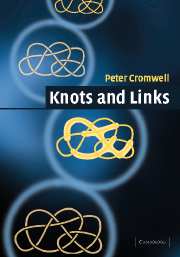Book contents
- Frontmatter
- Contents
- Preface
- Notation
- 1 Introduction
- 2 A Topologist's Toolkit
- 3 Link Diagrams
- 4 Constructions and Decompositions of Links
- 5 Spanning Surfaces and Genus
- 6 Matrix Invariants
- 7 The Alexander–Conway Polynomial
- 8 Rational Tangles
- 9 More Polynomials
- 10 Closed Braids and Arc Presentations
- Appendix A Knot Diagrams
- Appendix B Numerical Invariants
- Appendix C Properties
- Appendix D Polynomials
- Appendix E Polygon Coordinates
- Appendix F Family Properties
- Bibliography
- Index
6 - Matrix Invariants
Published online by Cambridge University Press: 05 June 2012
- Frontmatter
- Contents
- Preface
- Notation
- 1 Introduction
- 2 A Topologist's Toolkit
- 3 Link Diagrams
- 4 Constructions and Decompositions of Links
- 5 Spanning Surfaces and Genus
- 6 Matrix Invariants
- 7 The Alexander–Conway Polynomial
- 8 Rational Tangles
- 9 More Polynomials
- 10 Closed Braids and Arc Presentations
- Appendix A Knot Diagrams
- Appendix B Numerical Invariants
- Appendix C Properties
- Appendix D Polynomials
- Appendix E Polygon Coordinates
- Appendix F Family Properties
- Bibliography
- Index
Summary
In this chapter we introduce some invariants that are more sophisticated. In comparison with the ‘minimise a geometrical property’ type of invariant, they are more difficult to define. However, they have the great advantage that they can be directly calculated. They are powerful enough to distinguish many of the knots with at most nine crossings: we can finally prove that non-trivial knots do exist, and also that some knots are cheiral. We can even find a computable lower bound on the unknotting number, which allows the unknotting numbers of some knots to be established.
We start by analysing the set of loops on a surface. With an appropriate rule of composition, these form a group called the first homology group of the surface. By studying the ways these loops are arranged in space, we obtain a matrix which is dependent on the embedding of the surface. This then leads to numerical invariants of the surface boundary. (The chapter title is something of a misnomer since the matrix itself is not a link invariant, only the numbers derived from it.) Readers familiar with homology theory can skip to §6.5.
Loops in graphs
Let G be a connected oriented graph with vertex set V and edge set E. Each edge e ∈ E is an ordered pair [vi, vj]: the edge is oriented from vi to vj.
- Type
- Chapter
- Information
- Knots and Links , pp. 129 - 156Publisher: Cambridge University PressPrint publication year: 2004



